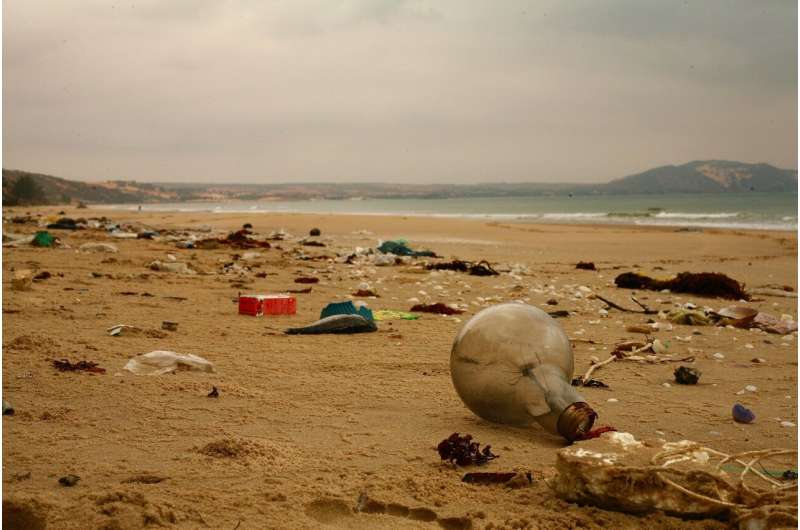Socioeconomic factors influence land and seafloor pollution

The research was conducted by scientists at CSIRO, Australia's national science agency; Ocean Conservancy, a U.S.-based advocacy non-profit; and the PADI AWARE Foundation, a non-profit public charity that drives global ocean conservation through local action.
In the first global analysis of its kind, the research team used comprehensive data obtained from 22,508 land-based cleanups as part of Ocean Conservancy's International Coastal Cleanup across 118 countries (2011–2017) and 7,290 seafloor cleanups conducted through the PADI AWARE Foundation's Dive Against Debris program in 116 countries (2011–2018).
CSIRO Senior Research Scientist and study leader Dr. Denise Hardesty said the total amount of plastic pollution was higher where there was more built infrastructure, such as near cities. Less pollution was found in areas with higher national wealth.
"Pollution hotspots were found in every inhabited continent on Earth, not just in those places that have previously been identified as the biggest polluters," Dr. Hardesty said.
Hotspots of individual litter items, such as cigarette butts or food wrappers, were differentially driven by socioeconomic factors. For example, a positive correlation between cigarette butts and national wealth was found.
The study found that where local population increases, single use-packaging such as takeaway food and beverage containers also increase.
"Hotspots of plastic pollution also reflect the patterns of local deposition, waste management and accumulation. By identifying these locations using real data, local decision makers can assess opportunities on where and how to implement effective policies to reduce plastic in the environment," Dr. Hardesty said.
"Given the sheer volume of single-use packaging items recorded, changing the way we use and dispose of these items will likely substantially reduce the amount of litter found on land, in our waterways, and on the bottom of the ocean."
Chief Scientist at Ocean Conservancy, Dr. George Leonard, said that the research demonstrated the global and heterogeneous nature of plastic pollution.
"Our research highlights the need for local policies and actions targeted to reduce plastic pollution, before it gets into the environment," said Dr. Leonard.
"Our study makes a strong case that beach and underwater cleanups provide critical, complementary data about the extent of plastic pollution in the environment," said Dr. Leonard.
Policy Lead for PADI AWARE Mr. Ian Campbell said the research demonstrated the critical need for empirical debris data from both land and seafloor surveys—and the importance of global datasets and large-scale citizen science projects.
"Litter that is found on land is not a reliable indicator for seafloor debris and vice versa, as different factors influence where and what types of debris are found on land and on the seafloor, although some items are common to both," Mr. Campbell said.
"We found that some seafloor debris hotspots were associated with partially landlocked seas."
Dr. Hardesty said the research highlighted the valuable role that citizen science can have in providing scientifically robust data with real management and policy implications.
"This research could not have been done without the information collected by hundreds of thousands of citizen scientists conducting tens of thousands of cleanups world-wide," Dr. Hardesty said.
Plastic pollution findings:
- Contrary to some prevailing messaging about plastic pollution being a problem for the global south, plastic pollution hotspots are everywhere.
- The 10 most abundant items on land (in order ranked 1-10) included cigarette butts, food wrappers, plastic beverage bottles, plastic bottle caps, plastic bags, plastic straws, plastic take-away containers, plastic lids, and foam take-away containers and plastic pieces (fragments).
- The ten most common items found on the seafloor included (in order from 1-10) fishing line, plastic pieces, glass bottles, plastic beverage bottles, food wrappers, metal cans, plastic bags, fishing gear, plastic cutlery, and rope.
- Plastic beverage bottles were common in tropical countries, like Jamaica and Costa Rica.
- Plastic food wrappers were abundant in Southeast Asia, particularly around the Philippines and Indonesia
- Mass transit hubs, like train stations, are often hubs for single-use food and beverage packaging, but not items with recycling value.
- Cigarette butts were commonly found in South Europe and North Africa.
- Hotspots for fishing line occurred in Australia, UK and U.S., where recreational fishing is a common pastime.
More information: Britta Denise Hardesty et al, Socioeconomics effects on global hotspots of common debris items on land and the seafloor, Global Environmental Change (2021). DOI: 10.1016/j.gloenvcha.2021.102360
Provided by CSIRO



















